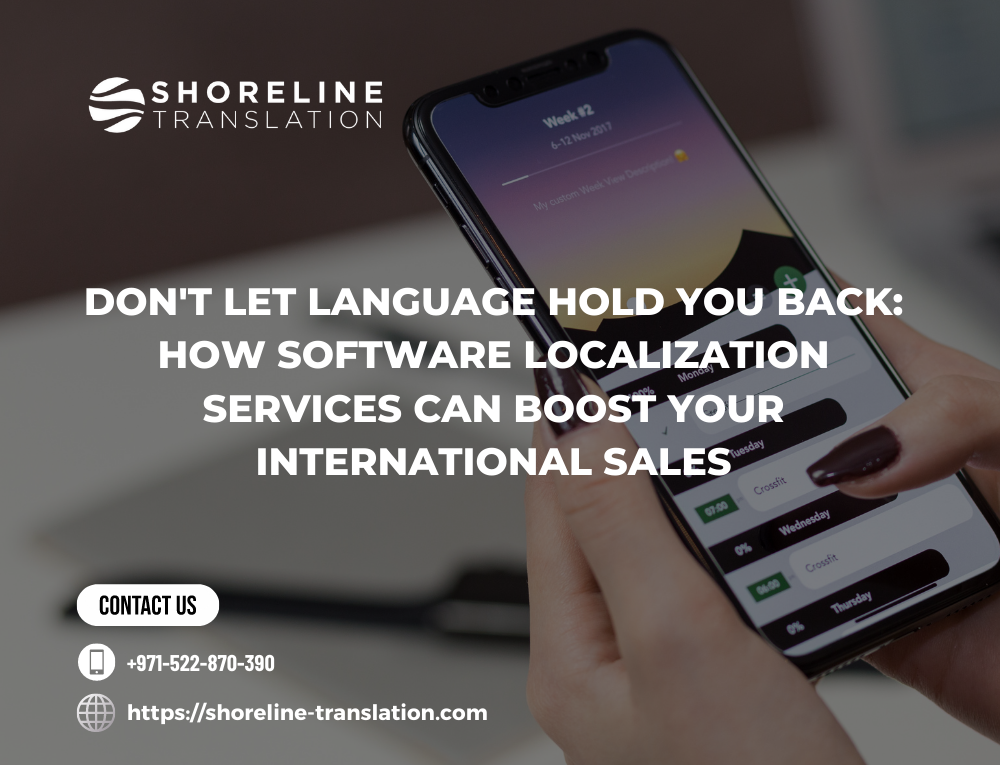Table of Contents
ToggleDon’t Let Language Hold You Back: How Software Localization Services Can Boost Your International Sales
Welcome to the global marketplace, where borders are blurred, and international sales opportunities are endless. But hang on a minute – is your software language holding you back from reaching new markets? Don’t worry; you’re not alone! Many businesses struggle to penetrate foreign markets due to linguistic barriers. Thankfully, there’s a solution: software localization services. They can help translate your software into multiple languages without losing its essence or functionality. In this blog post, we’ll explore the world of software localization services and how they can boost your international sales. So buckle up and get ready for an exciting ride!

Understanding Software Localization
Software localization is the process of adapting software to meet the linguistic, cultural, and functional requirements of a specific region or country. In other words, it’s about customizing your software to cater to different language preferences and cultural nuances.
Localization goes beyond mere translation; it ensures that the software looks native and functions as expected in any target market. It involves modifying user interfaces, technical documentation, audiovisual content, mobile apps, and even small texts like error messages or notifications. By doing so, businesses can easily tap into new markets while providing their users with an exceptional experience.
Why Software Localization is Important for International Sales
Your users may struggle with difficult-to-understand interfaces or poorly translated content without proper localization. This can lead to frustration, negative reviews, and ultimately lost sales. Software localization helps you reach a wider audience in an increasingly interconnected world while ensuring your brand message isn’t lost in translation!
Types of Software Localization Services
Software localization services come in different types, and each one plays a vital role in the overall process. One of the most common types is User Interface Localization. This type involves adapting the user interface components, including menus, buttons, and dialog boxes to match local language preferences.
Another critical type of software localization service is Technical Documentation Localization. This kind ensures that all technical materials such as manuals and guidelines are translated accurately into regional languages without losing their original meaning.
Other kinds include Audio and Video Localization for multimedia content, Mobile Software Localization for apps or games running on mobile devices, Software Localization Testing for quality assurance purposes, and finally Translation of Small Texts like error messages or other system notifications.
User Interface Localization
User Interface Localization is crucial in making your software accessible to users around the world. It involves adapting the language, formatting, and design of your application’s user interface to match the cultural norms and preferences of different regions.
This means more than just translating text on buttons and menus. It also involves ensuring that icons, images, colors, and even layouts align with local customs. With User Interface Localization services from a reputable provider, you can ensure that your software resonates with international audiences while retaining its functionality and usability.
Localization of Technical Documentation
These documents need to be localized accurately as they provide valuable information about the software’s functionality and features. This ensures that users can successfully navigate through the product without any confusion or misunderstandings. Technical documentation localization helps create a seamless experience for your international customers while also building trust in your brand.
Localization of Audio and Video
Imagine watching a video or listening to audio in an unfamiliar language, utterly confused. That’s where localization of audio and video comes into play! By adapting voiceovers, subtitles, animations, and graphics to suit the target audience’s language and culture, this service ensures your multimedia content resonates with users worldwide.
Not only does it improve user experience, but localized multimedia also supports brand consistency across borders. With properly localized audio and video content as part of your software package, you’re guaranteed a stronger global presence.
Mobile Software Localization
In today’s digital age, mobile devices have become an integral part of our lives. Smartphones and tablets are used for everything from entertainment to communication to work. As such, your software must be optimized for these devices in every way possible- including localization.
Mobile software localization involves adapting the application or website to suit the specific language and cultural preferences of users in different regions around the world. This includes adjusting not only text but also graphics, images, colors, and other aspects of design to ensure a seamless user experience on mobile screens.
Software Localization Testing
Picture this: You’ve invested time, money, and effort into localizing your software for a new market. Everything seems perfect – until you launch it and realize that there are major bugs in the localized version. This can be not only embarrassing but also costly.
That’s where software localization testing comes in. It involves testing your localized software to ensure that it works as intended, without any errors or bugs specific to the target language or culture. With professional localization testing services, you can rest assured that your software will function flawlessly in any region of the world, maximizing its effectiveness and enhancing user experience.
Translation of Small Texts
When it comes to software localization, even the tiniest details matter. That’s why the translation of small texts is crucial for ensuring a seamless user experience across multiple languages and cultures.
Whether it’s a button label or an error message, accurate translations of small texts can make all the difference in how your software is perceived by international users. And with the help of professional localization services, you can rest assured that every single word will be carefully translated and adapted for maximum impact.
Key Benefits of Software Localization
Expanding your business globally has never been easier with software localization services. By localizing your software into different languages, you can access new markets and increase international sales. This means that you can connect with more customers worldwide and provide them with a better user experience.
Not only does software localization boost your sales, but it also saves costs in the long run. When using localized software, users face fewer language barriers and are more likely to use the product for longer periods. It’s a win-win situation: satisfied customers lead to increased revenue while reducing support costs for technical issues related to language barriers.
Access to New Markets
Expanding your business to new markets can be a daunting task, but software localization services can make it easier. By localizing your software, you are opening up doors to reach customers in different countries and cultures.
Not only does this increase your potential customer base, but it also allows for more personalized marketing strategies. By catering to the specific needs and language preferences of each market, you can create a stronger connection with potential clients. Don’t let language barriers hold you back from reaching new heights in global sales!
Improved User Experience
When it comes to software localization, improved user experience is one of the key benefits. By localizing your software, you can ensure that users in different countries and regions can interact with your product in a way that feels natural and intuitive.
Imagine trying to use a piece of software or an app that’s only available in a language you’re not familiar with. It can be frustrating and confusing, leading to a negative user experience. But by investing in software localization services, you can eliminate these barriers and create an interface that speaks directly to your users’ needs.
Cost-Effective Solution
We all know that expanding into international markets can be costly, but software localization services provide a cost-effective solution. By localizing your software, you save money on marketing and advertising campaigns as your product is now available to a whole new audience who are more likely to buy from you.
Moreover, by choosing the right localization service provider, you can benefit from affordable pricing models such as volume discounts or flat rates per project. This means that you only pay for what you need and don’t have to worry about additional costs like hiring extra staff or purchasing expensive equipment.
The Software Localization Process
Embarking on the software localization journey begins with thorough preparation and analysis. This initial stage involves identifying target languages, extracting translatable content, and determining cultural aspects that will impact the final product.
Next comes translation and localization where skilled linguists adapt your software to meet regional preferences. Following this is a rigorous testing phase for quality assurance before diving into the final implementation. Each step ensures a seamless transition into new markets while maintaining a top-notch user experience.
Preparation and Analysis
Before you start the software localization process, there are a few essential things to consider. Preparation and analysis are critical for successful software localization services. The preparation phase involves understanding your target audience, identifying cultural differences, considering local regulations and laws, and choosing appropriate language dialects or variants that suit the region’s preferences.
During the analysis stage of software localization, various components of your software undergo scrutiny to find out which elements need translation or adaptation. This stage includes reviewing all text strings within your application – including menus and buttons – taking into consideration any graphic element that contains written content in images such as banners or logos used on different pages. In a nutshell, proper planning ensures smooth execution!
Translation and Localization
When it comes to software localization, translation, and localization are two peas in a pod. They work hand-in-hand to communicate effectively with your target audience. Translation involves adapting the language of your content into another language, while localization takes it a step further by considering cultural nuances and other regional differences.
The translation is not just about swapping words from one language to another; it requires an understanding of culture-specific idioms, expressions, and customs. Localization takes this even further by accounting for layout requirements, date formats, measurement units, and currency symbols – all elements that can make or break the user experience. By combining translation and localization efforts, you will create software that speaks fluently to your global customers without missing a beat!
Testing and Quality Assurance
Once the software localization process is complete, it’s essential to test and assure its quality. This step ensures that your localized software works seamlessly in the target markets.
The testing phase includes functional, linguistic, and cosmetic tests to ensure that all aspects of the localized software work as expected. Quality assurance involves checking for any errors or bugs that could affect your end-users experience. With thorough testing and quality assurance measures in place, you can confidently launch your product into new international markets with peace of mind knowing it meets local standards.
Final Implementation
The final implementation phase is where all the hard work and effort pay off. It’s the moment of truth when you finally get to see your software in action, fully localized and ready for global users. This stage involves rolling out the new version of your product or service to international markets, ensuring that everything runs smoothly without any glitches.
During this phase, it’s important to keep a close eye on user feedback so you can quickly address any issues that arise. Once your software localization project has been successfully implemented, don’t forget to celebrate with your team! After all, it takes teamwork and dedication to achieve such an impressive feat.
Choosing the Right Software Localization Service Provider
When it comes to choosing the right software localization service provider, experience and expertise are crucial. Look for a company that has been in the industry for years and has a proven track record of success.
Quality and accuracy should also be top priorities. Make sure the provider you choose offers high-quality translations with accurate terminology to ensure your software is properly localized for your target market. Additionally, seek out providers who offer excellent customer support and cost-effective pricing models to maximize your investment.
Experience and Expertise
When it comes to choosing the right software localization service provider, experience, and expertise are key factors to consider. You want a team that has been in the industry for years and can offer a wealth of knowledge on best practices and potential challenges.
Look for a company that has worked with businesses similar to yours, as this indicates they have a deep understanding of your target audience and industry-specific terminology. With experienced professionals on your side, you can feel confident that your software will be accurately translated and culturally adapted for maximum impact in new markets.
Quality and Accuracy
When it comes to software localization, quality, and accuracy are crucial. A small error can ruin the user experience and damage your brand reputation. That’s why you need a localization service provider that ensures top-notch quality control processes.
Quality starts with the translation process. The translators should be native speakers of the target language and have expertise in your industry or niche. Accuracy, on the other hand, involves more than just translating words correctly; it also means using appropriate terminology, cultural references, and idiomatic expressions that resonate with your target audience. With a reliable software localization partner, you can rest assured that every aspect of your content is carefully reviewed for accuracy before final implementation.
Customer Support
When it comes to software localization services, customer support plays a crucial role in ensuring the success of your international expansion. That’s why it’s important to choose a provider that offers responsive and reliable customer service.
Whether you have questions about the localization process or need assistance with technical issues, a good provider will be there for you every step of the way. Look for companies that offer multiple channels of communication, such as phone, email, and live chat support. With top-notch customer support on your side, you can confidently take your business global!
Cost-Effective Pricing Models
We all know that the cost of software localization can be a significant investment, but it doesn’t have to break the bank. With so many pricing models available, it’s important to choose one that aligns with your budget and goals.
One popular option is per-word pricing, which charges based on the number of words in your content. Another approach is hourly pricing, which allows for more flexibility in terms of edits and revisions. Whatever model you choose, make sure it works for both you and your localization service provider.
Best Practices for Software Localization
When it comes to software localization, some best practices can help ensure a smooth and successful process. One of the most important best practices is internationalization. This means designing your software with localization in mind from the beginning so that it can easily adapt to different languages and cultures.
Another key best practice is using a localization-friendly design. This includes avoiding text strings that are too long or complex, as well as using graphics instead of text where possible. Consistent terminology is also crucial for effective software localization – using the same words and phrases consistently throughout your software will make it easier for users to understand and navigate, no matter what language they speak.
Internationalization
Internationalization is a critical aspect of software localization services. It involves designing and developing your software in such a way that it can be adapted easily to different languages and cultures. This means creating an infrastructure that allows for the flexible integration of localized content without disrupting or breaking the core functionality.
By focusing on internationalization, you are laying the foundation for successful software localization. By incorporating best practices from the start, you will save time and cost during the translation process while also ensuring maximum usability for users across different regions and languages. With proper internationalization, your software will have smooth sailing toward global success!
Localization-Friendly Design
When designing software for a global audience, it’s important to consider localization from the beginning. One of the key aspects of this is creating a localization-friendly design. This means choosing colors, fonts, and graphics that are culturally appropriate and easily translatable.
For example, certain colors may hold different meanings in different cultures. Red is considered lucky in China but represents danger in Western countries. By considering these nuances early on, you can create a design that not only looks great but also resonates with your target audience and minimizes translation issues down the line.
Consistent Terminology
Imagine you’re reading a user manual for a product, and it uses different terms to describe the same feature or function. Confusing, right? This is why consistent terminology is crucial in software localization services.
When translating software into multiple languages, it’s important to maintain consistency across all translations. Using the same words and phrases for every language version ensures that users can easily identify features and understand how to use them. It also helps establish brand recognition across different markets.
So next time you’re using an app or program with seamless navigation between languages, thank the team who ensured consistent terminology was employed throughout the localization process!
Case Studies: Successful Software Localization Examples
When it comes to software localization, success stories are abundant. Companies that have embraced this practice have seen significant growth in their international sales and customer base. Take for example Dropbox, a file-sharing service that localized its platform into 17 languages, resulting in a 400% increase in sign-ups from non-English speaking countries.
Another company that benefited greatly from software localization is Airbnb. The online marketplace for lodging expanded its platform to support over 60 languages and saw an increase of up to 1000% in bookings from certain regions. These case studies demonstrate the power of software localization services and how they can help businesses reach new markets and achieve exponential growth.
Shoreline Translation Provide Software Localization Services
In today’s globalized world, it’s essential to expand your business internationally. However, language barriers can hinder this process and make it difficult for businesses to reach their full potential. That’s where software localization services come in – they bridge the gap between language and international success.
By localizing your software, you can access new markets and improve the user experience while also saving costs on expensive translation fees. The software localization process requires expertise and a high level of accuracy, which is why choosing the right service provider is crucial.
Shoreline Translation provides top-quality software localization services that are tailored to meet your specific needs. With years of experience in the industry, Shoreline Translation has become a trusted partner for many businesses looking to expand globally.
Their team of expert linguists ensures that all translations are accurate and culturally appropriate, while also maintaining consistency across different languages. They also offer cost-effective pricing models without compromising quality or customer support.
So if you’re ready to take your business international but don’t want language barriers holding you back, turn to Shoreline Translation for reliable software localization services that will help boost your sales worldwide!
FAQs:
1. How long does the software localization process take?
The software localization process can take anywhere from a few weeks to several months, depending on the complexity of the project. Generally, larger and more complex projects will require more time for translation and adaptation.
2. Can all types of software be localized?
In general, any type of software can be localized, but the level of complexity will vary depending on the type of software. For example, mobile and web applications tend to require fewer adaptation steps than desktop applications.
3. Is it necessary to translate every part of my software for successful localization?
No, it is not necessary to translate every part of the software for successful localization. However, it is important to ensure that all language-specific elements such as text strings, images, and user interface elements are translated to ensure that the localized version of your software works correctly.
4. What is the best approach to localizing my software?
The best approach to localizing your software is to begin by making a comprehensive list of all language-specific elements that need to be translated, such as text strings, images, and user interface elements. Once this list is created, you can then assign each element to a professional translator or localization team for translation. Finally, it’s important to test the localized version of your software to make sure that everything works correctly.
Conclusion
As we have seen, software localization is a crucial component of any successful international sales strategy. By adapting your software to the cultural and linguistic preferences of your target audience, you can boost user engagement, improve customer satisfaction, and ultimately increase revenue. To get started with software localization services, begin by researching reputable providers that offer experience and expertise in your industry. Look for quality and accuracy in their work as well as cost-effective pricing models and excellent customer support. In addition to choosing the right provider, it’s also important to follow best practices such as internationalization and localization-friendly design. And don’t forget consistency in terminology! With these steps in mind, you’ll be on your way to successful software localization. So go forth and expand your reach into new markets – the world is waiting!





